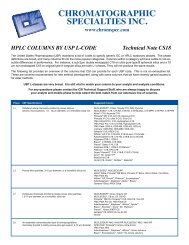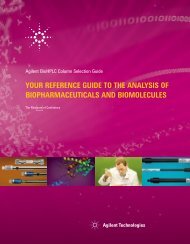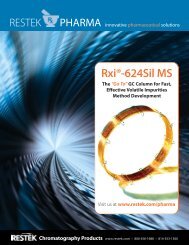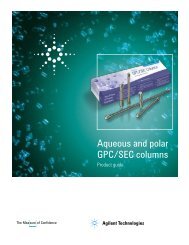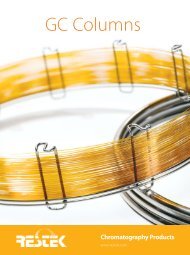Optimizing the Analysis of Volatile Organic Compounds
Optimizing the Analysis of Volatile Organic Compounds
Optimizing the Analysis of Volatile Organic Compounds
You also want an ePaper? Increase the reach of your titles
YUMPU automatically turns print PDFs into web optimized ePapers that Google loves.
Narrow-bore Systems (0.18mm ID - 0.32mm ID columns)<br />
Narrow-bore columns (0.18mm ID-0.32mm ID) <strong>of</strong>fer higher resolution, compared to<br />
0.45mm ID or 0.53mm ID columns. Because <strong>the</strong>se columns typically are operated at lower<br />
flow rates, <strong>the</strong>y are not compatible with <strong>the</strong> fast desorb flow rates from common purge and<br />
trap systems. Splitting <strong>the</strong> sample at <strong>the</strong> injection port or cry<strong>of</strong>ocusing (i.e., secondary trapping)<br />
will provide compatibility and help focus <strong>the</strong> sample at <strong>the</strong> column inlet.<br />
Splitting <strong>the</strong> Sample: Many environmental laboratories analyzing VOCs by GC/MS use narrow-bore<br />
capillary columns and split <strong>the</strong> sample at <strong>the</strong> injection port. Higher sensitivity ion<br />
trap GC/MS systems (e.g., Varian Saturn 2000 and Thermo Finnigan GCQplus systems)<br />
7 and recently developed quadrapole MS systems (e.g., <strong>the</strong> Agilent 5973 system) allow<br />
high split ratios in <strong>the</strong> injection port while maintaining sensitivity adequate to meet <strong>the</strong><br />
requirements <strong>of</strong> EPA Method 524.2. 8 Older quadrapole GC/MS systems require an increase<br />
in purge volume (25mL) to compensate for <strong>the</strong> sample lost due to splitting.<br />
Using a standard split/splitless injection port to split <strong>the</strong> desorb flow allows a higher desorb<br />
flow rate while maintaining a lower column flow. With this technique, <strong>the</strong> trap is desorbed<br />
at a flow rate <strong>of</strong> 10-60mL/min. and <strong>the</strong> column flow rate is adjusted to 1.0-1.3mL/min.,<br />
which is compatible with <strong>the</strong> vacuum system <strong>of</strong> an MS. The remaining flow exits through<br />
<strong>the</strong> split vent. The faster desorb flow rate produces a narrow sample bandwidth which, when<br />
combined with <strong>the</strong> high efficiency <strong>of</strong> a narrow-bore column, allows high split ratios without<br />
significant loss in sensitivity. 8 Surprisingly, a 1:20 split ratio provides more sensitivity than a<br />
1:10 split ratio, because <strong>the</strong> higher flow from <strong>the</strong> trap focuses <strong>the</strong> target compounds more<br />
efficiently.<br />
Cry<strong>of</strong>ocusing (secondary trapping): A cry<strong>of</strong>ocusing unit refocuses <strong>the</strong> volatile compounds<br />
at <strong>the</strong> inlet <strong>of</strong> <strong>the</strong> narrow-bore column. This allows <strong>the</strong> trap to be desorbed at only 1-<br />
2mL/min., while improving peak shape and resolution by reducing sample bandwidth.<br />
Cry<strong>of</strong>ocusing takes place on a short length <strong>of</strong> deactivated, uncoated, fused silica tubing that<br />
is cooled to -160°C using liquid nitrogen. To increase retention for very volatile gases, or<br />
when analyzing Freon ® compounds, use tubing coated with a thick film <strong>of</strong> stationary phase.<br />
While cry<strong>of</strong>ocusing greatly improves peak shapes from narrow-bore columns, <strong>the</strong> approach<br />
consumes large amounts <strong>of</strong> liquid nitrogen, increasing operating expenses and requiring liquid<br />
nitrogen tanks in <strong>the</strong> lab. If <strong>the</strong> liquid nitrogen tank empties in <strong>the</strong> middle <strong>of</strong> a sample<br />
sequence, <strong>the</strong>re can be significant downtime before <strong>the</strong> tank is replaced.<br />
Capillary Column Phases<br />
Many capillary columns have been designed for <strong>the</strong> analysis <strong>of</strong> VOCs. Column selection<br />
normally is based on <strong>the</strong> analytical method (e.g., US EPA method), compound list, and<br />
detection system used. This section serves as an overview <strong>of</strong> <strong>the</strong> different phases used for<br />
VOC analyses. See <strong>the</strong> Applications section (page 37) for examples <strong>of</strong> GC and GC/MS separations<br />
under specific conditions.<br />
The first columns used for analyzing volatiles were based on diphenyl/dimethyl polysiloxane<br />
stationary phases. These include VOCOL ® , Rtx ® -<strong>Volatile</strong>s, HP ® -VOC, and Rtx ® -502.2<br />
columns. The main advantages <strong>of</strong> <strong>the</strong>se phases are <strong>the</strong>ir resistance to oxidative breakdown<br />
and <strong>the</strong>ir lower bleed, compared to cyanopropylphenyl polysiloxane (i.e., “624”) phases.<br />
The major drawback <strong>of</strong> diphenyl/dimethyl polysiloxane phases is <strong>the</strong> incomplete resolution<br />
<strong>of</strong> bromomethane and chloroethane. Many environmental laboratories still use <strong>the</strong>se<br />
columns, especially when analyzing samples for a limited set <strong>of</strong> compounds.<br />
7. Jessie Crockett Butler, Meredith Conoley, "<strong>Analysis</strong> <strong>of</strong> <strong>Volatile</strong> <strong>Organic</strong>s in Solid Wastes, Soils, and<br />
Water Using a Split Injection and <strong>the</strong> Polaris Q Ion Trap GC/MS." Application Note AN9167.<br />
Thermo Finnigan, GC and GC/MS Division, Austin, TX.<br />
8. D.R. Decker, J.J. Harland, and M.J. Feeney, "Comparison <strong>of</strong> Detection Limits and <strong>Analysis</strong> Time<br />
Using Wide and Narrow Bore Capillary Columns for Purge-and-Trap GC/MS Analyses." OI<br />
Analytical. Application Note 02850896.<br />
21<br />
www.restekcorp.com





